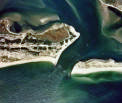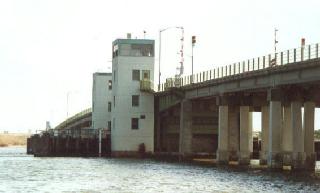oriches Bay and its
rivers,
creeks and coves is the smallest and shallowest of the chain of south shore of
Long Island bays. The shallow aspect carries with it some good and some
bad. The good is there are deep channels that lie adjacent to very shallow water making great structure
for stripers to ambush prey. The bad is as summer
progresses the water can really heat up and in turn will keep the bass away from the
shores of the northern parts of the bay and most parts that are not near the inlet. In addition, there is heavy boat traffic during the boating season and this activity will usually sound the fish for most of the day on the weekend. One successful solution is to
fish at night or, if possible, fish daytime during the week.
There are three sources of sea water that feed the bay: Moriches Inlet, the Great South
Bay and Shinnecock Bay. Striped bass can be found where Moriches Bay
meets these three sources. As one will see, these three areas are
quite different from one another. The structure is different, as well as water temperature and the methods to work.
The inlet is a complex of deep fast moving water with an east and west
jetty. As the water enters the  bay it follows two channels or "cuts". The
east cut runs along Cupsogue Beach, follows the "Elbow" into a channel
with flats on either side and meets the main channel at buoy
#24. The west cut flows past Great Gun Beach where there are also
flats and sandbars. This channel, too, eventually connects to the
main channel at Can #16. The east and west cuts are deep channels
that are adjacent to sloughs, flats and sandbars. Moving a bit further
away there are flats that meet more deep water. This water is
unbelievably clear. Most of the time one can see bottom detail in water
that is 15 feet deep. The bottom is white sand and this area can look
like a tropical flats on bright and clear summer days. This
area of the bay contains excellent structure for stripers as well as
fluke.
bay it follows two channels or "cuts". The
east cut runs along Cupsogue Beach, follows the "Elbow" into a channel
with flats on either side and meets the main channel at buoy
#24. The west cut flows past Great Gun Beach where there are also
flats and sandbars. This channel, too, eventually connects to the
main channel at Can #16. The east and west cuts are deep channels
that are adjacent to sloughs, flats and sandbars. Moving a bit further
away there are flats that meet more deep water. This water is
unbelievably clear. Most of the time one can see bottom detail in water
that is 15 feet deep. The bottom is white sand and this area can look
like a tropical flats on bright and clear summer days. This
area of the bay contains excellent structure for stripers as well as
fluke.
The connection with Shinnecock Bay involves a series of bridges crossing narrow canels in West Hampton. Before and after the vacation season this area is quiet and can produce big time.
The connection with the Great South Bay is divided by the
Smith's Point Bridge (Click on
the image of Smith's Point Bridge to get
realtime tide and water temperature information). Though this
area is fished mostly for fluke, flounder
as well as blues and weakfish, stripers will
be around throughout the season and especially in the fall. There are
some deep holes that
can only be accessed by either boat or kayak but one can wade the shore
that is behind the beach parking lot.
Smith's Point Bridge to get
realtime tide and water temperature information). Though this
area is fished mostly for fluke, flounder
as well as blues and weakfish, stripers will
be around throughout the season and especially in the fall. There are
some deep holes that
can only be accessed by either boat or kayak but one can wade the shore
that is behind the beach parking lot.
Freshwater enters the bay by way of the many feeder creeks that lie all along the northern side. These vary in size
and are always worth a try at the right times. They are also the
source of fertilizer (nitrogen) run-off. As summer progresses so
does the growth of sea-lettuce (ulva) and other vegetation near the
shore. As the tide changes and the flow begins to move, islands
of fresh plant matter will make fishing difficult and at night it can
be treacherous for the wading fisherman as 12-foot patches float
by or worse
float by below the water at ankle height. Always be aware of your
surroundings.

